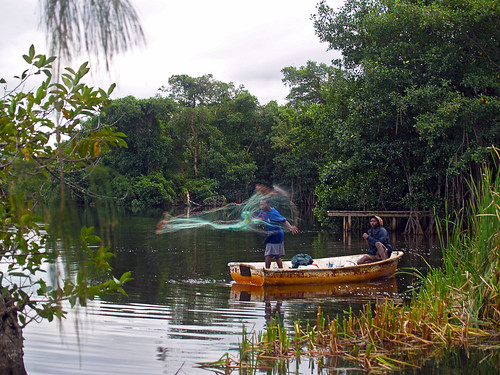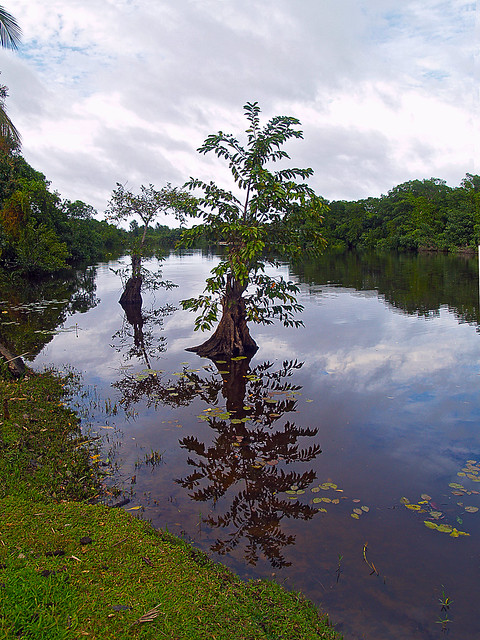Garifuna fishermen, Punta Izopo, Tela
Wednesday, September 07, 2011 at 11:26 AM by Adalberto H. Vega
Around 10AM these Garifuna fishermen will pack their nets and head to their huts with today's lunch: a few fresh fish caught from the Río Platano canals in Punta Izopo National Park as they have been doing since over a couple centuries when they first arrived to Honduran Caribeban Coast after being sent away from Saint Vincent Island.
Alrededor de las 10am estos pescadores Garífunas recogerán sus atarrayas y retornarán a sus cabañas con el almuerzo del día: unos cuantos pescados recién obtenidos de la desembocadura del Río Plátano en el Parque Nacional Punta Izopo como lo han venido haciendo a diario desde su llegada a las Costas del Caribe Hondureño hace más de dos siglos luego de ser enviados lejos de su natal isla de San Vicente.
A few Km. from Tela, Atlántida in Honduras, Punta Izopo National Park main attraction is the Rio Platano, where you can kayak through a maze of mangroves admiring an impressive landscape and plenty of aquatic birds, howler, spider and cappuccino monkeys and some crocodiles. An exciting way of spending half day, and then enjoy a typical Garifuna lunch at the community of Triunfo de La Cruz.
interests: birds, birdwatching, exotic plants, flowers, garifuna, Honduras, kayaking, living cultures, tropical, wild life 0 comments
Artisan's street, Copan Ruinas
at 11:16 AM by Adalberto H. Vega
The artisans' street in Copan Ruinas. Every weekend, this street is blocked to vehicles, and turned into a pedestrians' way, where everybody can admire and buy at bargain prices some excellent artwork and crafts exhibited by local and regional artisans. One of the little details that make this acquainted charming little town a true gem for tourists, besides the majestic Copan Maya Ruins.
La calle de los artesanos en Copan Ruinas. Cada fin de semana, esta vía se cierra al tránsito vehicular convirtiéndose en una peatonal donde los artesanos locales e internacionales exponen sus magníficas obras, las cuales estána la venta a precios muy razonables. Es una de las cosas de las que pueden disfrutar los visitantes en este pacífico y encantador pueblecito del Oeste de Honduras, además de las magníficas Ruinas de Copán.
interests: Copan Ruinas, handicrafts, Honduras, living cultures 1 comments
MC Tours Honduras Launches New Redesigned Website
Friday, August 12, 2011 at 1:56 PM by Adalberto H. Vega
MC Tours - Honduras redesigned website as a vital communication tool for its clients, business partners and for all the traveler community interested in Honduras.The result is an improved website which offers a fresh new look that technically provides its online visitors with significant improvements in navigation and resources to easily locate what they are looking for.
 The Website located in http://mctours-honduras.com includes a better structured navigation aimed for the visitor to easily find interesting information which will be a great help in selling Honduras destination. The products/services are grouped together in a logical way, according to type, including some specific sections that filter the content according to the travelers’ interest, providing a cross-reference throughout all the website content to quickly find wanted information. This combined with the powerful dynamic search feature, with all pages carefully indexed with keywords, will make it easy for visitors to find everything they may need with a just few clicks.
The Website located in http://mctours-honduras.com includes a better structured navigation aimed for the visitor to easily find interesting information which will be a great help in selling Honduras destination. The products/services are grouped together in a logical way, according to type, including some specific sections that filter the content according to the travelers’ interest, providing a cross-reference throughout all the website content to quickly find wanted information. This combined with the powerful dynamic search feature, with all pages carefully indexed with keywords, will make it easy for visitors to find everything they may need with a just few clicks.The website is also mobile ready, so users will be able to conveniently navigate it from their iPhone, iPad, Android, or other smartphone mobile device while on the road.We are sure visitors will find the Resources – Videos section particularly useful; this section contains 17 recently produced videos about Honduras highlights which are a valuable tool to show prospect visitors the wonders of this beautiful country.
MC Tours - Honduras
Contact:
MC Tours - Honduras
Website: MC Tours - Honduras
LinkedIn: Follow MC Tours - Honduras on LinkedIn
Twitter: Follow MC Tours - Honduras on Twitter
Facebook: Find MC Tours - Honduras on Facebook
XML feed: MC Tours - Honduras feed
Carpets of Copan, Honduras
Saturday, July 30, 2011 at 2:24 PM by Adalberto H. Vega

Photo of the day - Carpets of Copan, Honduras | Gadling.com
Thanks Meg Nesterov for choosing our photo of Copan "Semana Santa" Carpets as Photo of the Day.
If the street above looks a little more colorful than the average road, it's because the carpet has been rolled out for Semana Santa, or holy week leading up to Easter. The "carpets" are made from colored sawdust and flowers and illustrate the Stations of the Cross. There are many reasons to visit Copan in the western region of Honduras, but the procession that will march down this street on Good Friday morning (April 6 in 2012, if you want to start planning) is a big draw; arrive early to admire the "carpets". Thanks to Flickr user Adalberto H Vega for capturing them before they got trampled!
interests: Copan Ruinas, Honduras, living cultures 0 comments
Honduras's Top 5 Best Destinations
Sunday, March 13, 2011 at 8:50 PM by Adalberto H. Vega
Located right in the middle of Central America, Honduras has plenty of different touristic sites for varied interests. From archaeological sites and towns with colonial buildings to almost a quarter of territory turned into protected areas for nature lovers, beautiful beaches spanning over 500 miles of its Caribbean North coast and crystal-clear warm water coupled with bleached sand beaches at the Bay Islands, a section of the Mesoamerican barrier reef, second largest of its kind in the world and first in biodiversity; living cultures that bear ancient traditions and authentic cultural heritage, and certainly the friendliest people in the region.
1. Copan
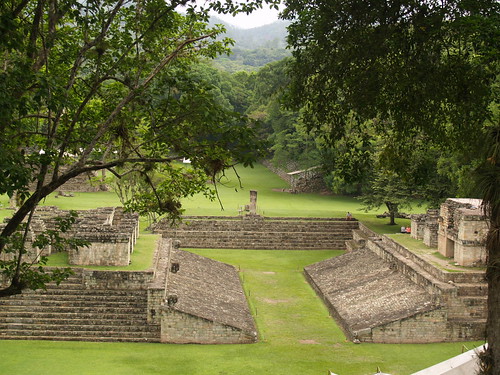 |
| Ball Court and Main Plaza, Copan Ruinas |
The southernmost Maya city–state of Copan flourished during a major Classic period from the 5th to 9th centuries AD, when Maya art and science development reached its peak just before mysteriously vanishing. You can enjoy a one-hour easy walk through the park, preferably with a local Tour Guide who will let you deep into the story of this fascinating place.
The Maya Sculpture Museum is one of the best in the region, holding the highest detail in original pieces found in the site protecting them from the elements as well as a full size replica of the Rosalila Temple, discovered in the late 80s, one of the intact temples preserved underneath one of the structures in the main site.
Besides the archaeological park, Copan has plenty of activities to keep you busy for a couple more days. There is the Copan Coffee Tour, a nice hike through shade grown coffee plantations under huge elderly trees inside an authentic primary rainforest just a 30-minute drive from town. Here you can learn about the harvesting and processing of this known bean variety that has become a key to most of our lifestyles.
At the Macaw Mountain Bird Park Reserve you will watch over 200 birds from different species such as macaws, parrots, toucans, owls, and hawks; some are flying freely in the park while others are kept inside spacious aviaries, and you can even have an encounter with some lucky ones at the interaction area. Most of these birds have been rescued from smugglers or donated from people who had them as pets, and since they were not able to survive alone in the wild, they are taken care of in the park.
The Luna Jaguar Hot Springs and Spa 50 minutes from town provides all necessary elements for a relaxing afternoon soothing your body, and for the more active people there is the Los Sapos Canopy Tour with 14 zip-lines (one of them over half a mile long and 650 feet above the ground) qualified by some people as one of the best in Central America.
2. Roatan and Utila
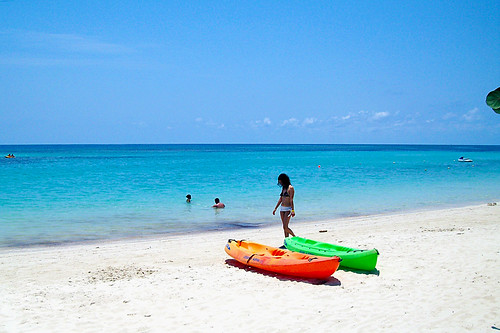 |
| West Bay Beach at Roatan, Bay Islands |
The Gumbalimba Natural Park has a zip-line, a jungle with a lagoon and an interaction area with monkeys and macaws, a nice hanging bridge and water sports, all available to spend a nice full day of fun and adventure. You can also visit a nice cameo factory, where you can see the ancient delicate art of carving mythical images in sea shells. There is also an iguana farm, glass bottom boat tours and dolphin encounters available for you.
Utila, the smallest of the Bay Islands is a true heaven for divers, it is the less expensive place in the planet to get PADI certification, a preferred spot for the impressively giant whale shark and plenty of marine life, still a truly enjoyable paradise not crowded at all.
3. Tela
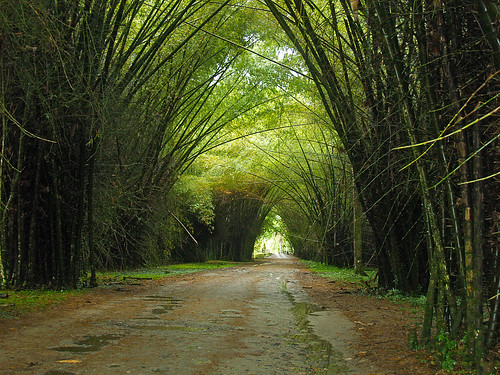 |
| Lancetilla Botanical Garden, Tela |
There are nice fully appointed resorts to enjoy some sunny days, and there are also four different protected areas in the surroundings: Jeannette Kawas National Park; accessible only by water, this park has some of the nicest beaches around and totally off the beaten path to have them only for you, there is plenty of wildlife to be seen such as howler, white-faced, and spider monkeys, alligators, many aquatic birds and (if you are lucky) some dolphins along the boat on the way in. Los Micos Lagoon is a place to go on a motor boat right past the Garifuna village of Miami where you can visit a Garifuna Museum and interact with the ethnic locals during their daily life.
Tela is also home to the Lancetilla Botanical Garden, the second largest botanical garden in the world, holding a wide variety of plants and trees from around the globe. This garden was built as a research facility by one of the banana companies and is now maintained by the government. The Punta Izopo Wildlife Reserve is an intricate maze of mangroves where you can kayak along to enjoy the peace of this remote area while watching some abundant wild life.
4. La Ceiba
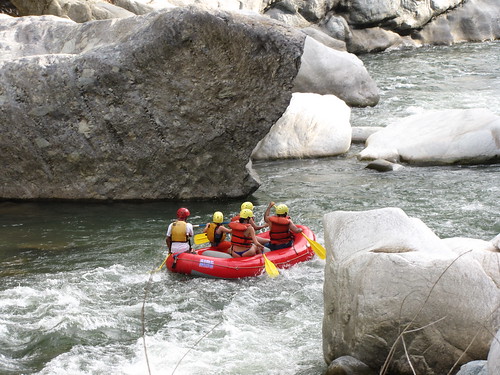 |
| Cangrejal River Rafting, La Ceiba |
Cuero y Salado Wild Life Refuge is a coastal manatee and wildlife refuge where the Cuero and Salado Rivers meet the ocean. The refuge contains over 13 square kilometers of tropical wet and mangrove forests. Monkeys, sloths, caimans, crocodiles, iguanas, and turtles are common sights together with over 350 species of birds. The refuge's most famous inhabitant is the elusive and endangered West Indian Manatee with an estimated population of 50 individuals. From the La Ceiba international airport you can fly to Roatan, Utila or Guanaja (the other two Bay Islands), although they can also be reached by a nice passenger’s speed-boat.
For those searching adrenaline kicks, the Cangrejal River offers class 4 and 5 rapids for one of the best white-water river rafting experiences. Last but not least from La Ceiba is Cayos Cochinos, an archipelago of several small cays all part of a protected area which has guaranteed a truly secluded experience in one of the most paradisaical spots around.
5. The Lenca Trail
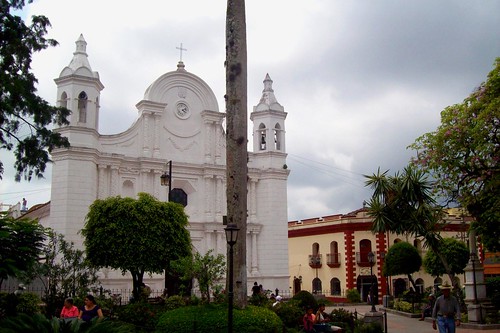 |
| Cathedral from Central Plaza, Santa Rosa de Copan |
----------
Honduras is a little less than 3 hours from main gateways in the United States by flight, with four international airports receiving daily flights from major airlines, being San Pedro Sula the main aerial entry for tourism. Getting around is easy, there is deluxe transportation service available, and private services can easily be arranged as well. There are hotels for every budget, and the locals are very friendly. English is widely spoken in Copan and Roatan and also by the staff of important hotels throughout the country.
interests: adventure travel, archeology, architecture, beach, Central America, Honduras, Roatan, travel guide, Utila 4 comments
The Church and Central Plaza, Copan Ruinas
Saturday, March 05, 2011 at 8:56 PM by Adalberto H. Vega
It is the same situation as any other town in Honduras (or Latin America) that has the typical layout of the Spanish cities, with the church opposite to the government building. The Central Plaza doesn't have any walls or tall edifications inside, because buildings around have even more historical value to be appreciated from the plaza itself.
Although a properly maintained—beautifully adorned Central Plaza contributes to the embellishment of the city, Central Plazas should not be crowded with vision-obstructive elements that impede the view of those historically valuable buildings.
The actual Plaza with all those decorations inside (and an unnecessary wall in the south side) was created by the same architect who designed the Central Plaza in Puerto Cortes, but the difference in that city as compared to Copan —no offense to the Porteños— is that the only pretty element in the city is the Plaza itself. There are no historical buildings around worthy of singular appreciation.
Let's hope the remodeling process won't suffer the same interference as the so—called garden refurbishing.
interests: architecture, Central America, church, Copan Ruinas, Honduras, photo sharing, photography 1 comments
author

- Adalberto H. Vega
- Copán Ruinas, Copan, Honduras
- Director of Marketing and Product Development MC Tours - Honduras leading Tour Operator from Central America. I am @ahvega on Twitter if you want to connect. See my Profile on Localyte.com
track your flight statusTrack Flight Status & more at www.flightstats.com | 
|
writing about
books i like
popular
- Belize Zoo in the "Top 10 zoos around the world"
- Big Ben and Parliament Square, London
- Cine Hispano - Santa Rosa de Copan
- The Church and Central Plaza, Copan Ruinas
- A good opportunity to visit Honduras
- Living in the Most Dangerous Country in the World
- Carpets of Copan, Honduras
- TRAVELLING IN CENTRAL AMERICA Safe or Dangerous
- Lake Suchitlan, Suchitoto, El Salvador
- Cine Hispano - Santa Rosa de Copan
